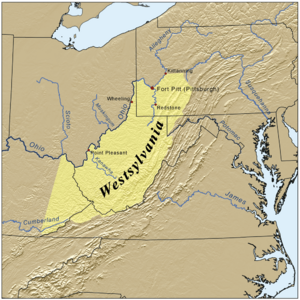Westsylvania facts for kids
Westsylvania was the name for a new state that people wanted to create in the early days of the United States. It would have been the fourteenth state and included parts of what are now West Virginia, southwestern Pennsylvania, and small areas of Kentucky, Maryland, and Virginia. This idea came up during the American Revolution.
Contents
Why Did People Want a New State?
Before the American Revolutionary War (1775–1783), there was a big argument over who owned the land west of the Allegheny Mountains, especially around Pittsburgh and along the Ohio River. Both the British colonies of Virginia and Pennsylvania claimed this area.
The Border Problem
The official border between Pennsylvania and Maryland was called the Mason–Dixon line. This line was supposed to help settle the argument between Virginia and Pennsylvania too. However, the survey for the Mason-Dixon line stopped in 1767 and wasn't finished until 1784. This meant that in the early 1770s, no one was sure if Pittsburgh and the surrounding areas belonged to Pennsylvania or Virginia. Both colonies acted as if the land was theirs. Virginia called the area the District of West Augusta, while Pennsylvania considered it part of Westmoreland County.
Big Land Claims
Adding to the confusion were large land claims by two companies: the Ohio Company of Virginia and the Indiana Land Company. These companies joined together in 1769 to form the Grand Ohio Company. Their goal was to create a new colony called Vandalia, which would have had borders similar to what Westsylvania later proposed. But the start of the American Revolutionary War stopped their plans for Vandalia.
Trying to Become a State
Many settlers living in this western region felt that the governments of Virginia and Pennsylvania were too far away. They believed these governments didn't care enough about the problems faced by people living on the frontier.
Asking Congress for Help
Inspired by the ideas of the American Revolution, in the summer of 1776, settlers in the area decided to declare their independence from Pennsylvania and Virginia. They sent a special request to the Second Continental Congress, asking for Westsylvania to be recognized as the fourteenth state.
In their request, called "The Memorial of the Inhabitants of the Country, West of the Allegheny Mountains," the settlers explained the border argument between Pennsylvania and Virginia. They worried this dispute would "in all Probability terminate in a Civil War" (meaning it could lead to a fight between the people). They also told Congress that "Land Jobbers" (people who illegally bought and sold land) were taking land from Native American tribes. The settlers feared this would cause "a bloody, ruinous & destructive War with the Indians."
To bring order to this confusing situation, the settlers asked that:
the Said Country be constituted declared & acknowledged a separate, distinct, and independent Province & Government by the Title and under the name of — 'the Province & Government of Westsylvania,' be empowered and enabled to form such Laws & Regulations & such a System of Polity & Government as is best adapted & most agreeable to the peculiar Necessities, local Circumstances & Situation thereof & its inhabitants invested with every other power, Right, Privilege & Immunity, vested, or to be vested in the other American Colonies, be considered as a Sister Colony & the fourteenth Province of the American Confederacy....
This meant they wanted Westsylvania to be its own independent government, able to make its own laws, and be treated like any other American colony, becoming the fourteenth state in the new American union.
Congress Says No
However, states that already had claims to western lands were not eager to let new frontier regions become independent. Because of this, Congress decided to ignore the petition from Westsylvania.
To strengthen its control over the area, Virginia reorganized the District of West Augusta in November 1776. It divided the land into three new counties: Ohio County, Monongalia County, and Yohogania County. Pennsylvania and Virginia finally settled their border dispute in 1780.
The Movement Continues
Even after the border was settled, the idea of Westsylvania didn't completely disappear. Virginians who suddenly found themselves living in Pennsylvania because of the new border were very upset. This feeling of wanting to separate was also strong among frontiersmen who felt the national government wasn't doing enough to protect them from Native American attacks during the last years of the Revolutionary War.
In 1782, Hugh Henry Brackenridge, a lawyer from Pittsburgh who strongly supported the national government, convinced the Pennsylvania Assembly to make it illegal to promote the idea of a separate state. This meant that anyone who continued to push for Westsylvania could face the death penalty. Pennsylvania also sent secret agents, like Reverend James Finley, to work against the Westsylvania movement.
According to historian Jack Sosin, Finley's efforts, the threat that settlers might lose their land, and the lack of support from Congress finally made the westerners quiet down. The dream of Westsylvania faded away.
See also
 In Spanish: Westsylvania para niños
In Spanish: Westsylvania para niños


